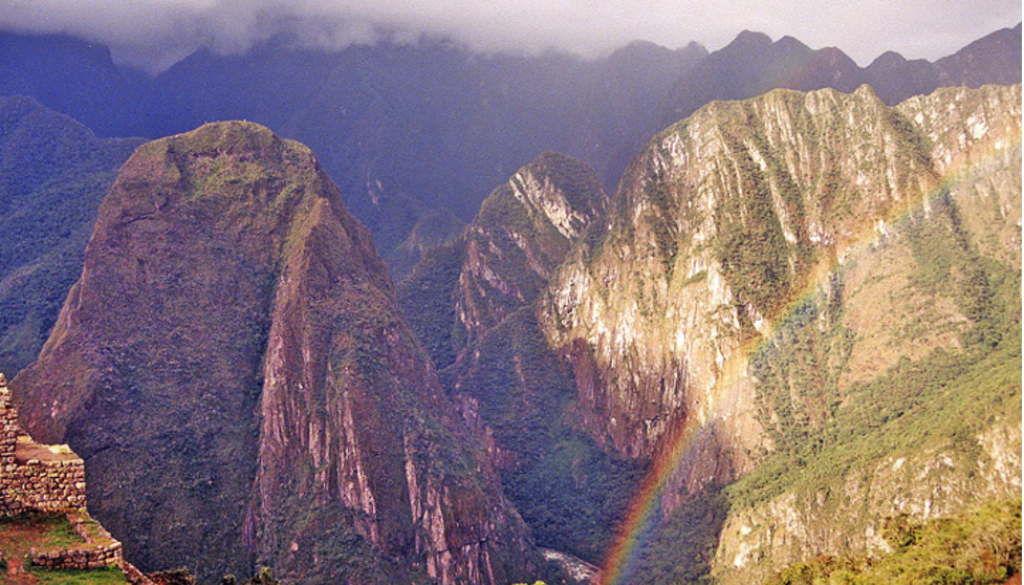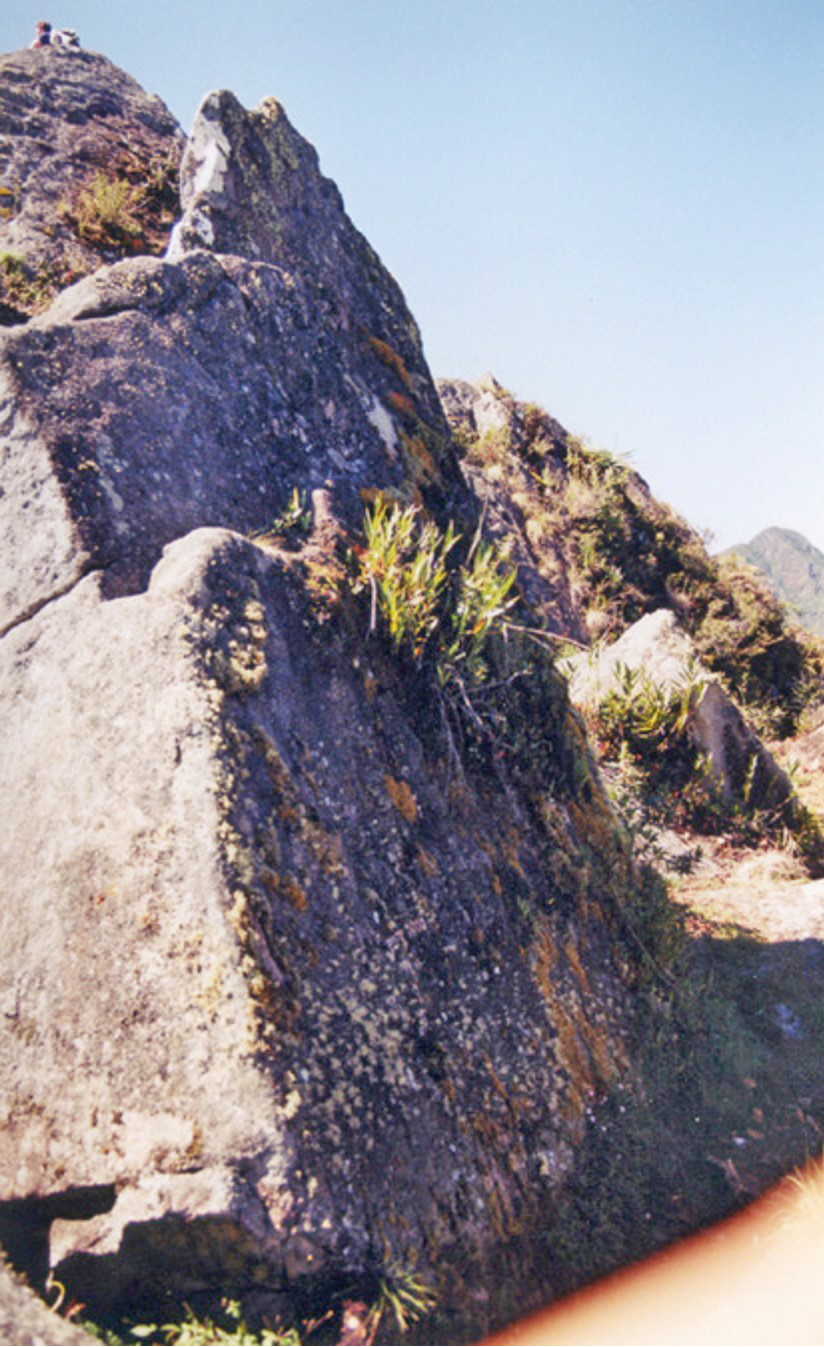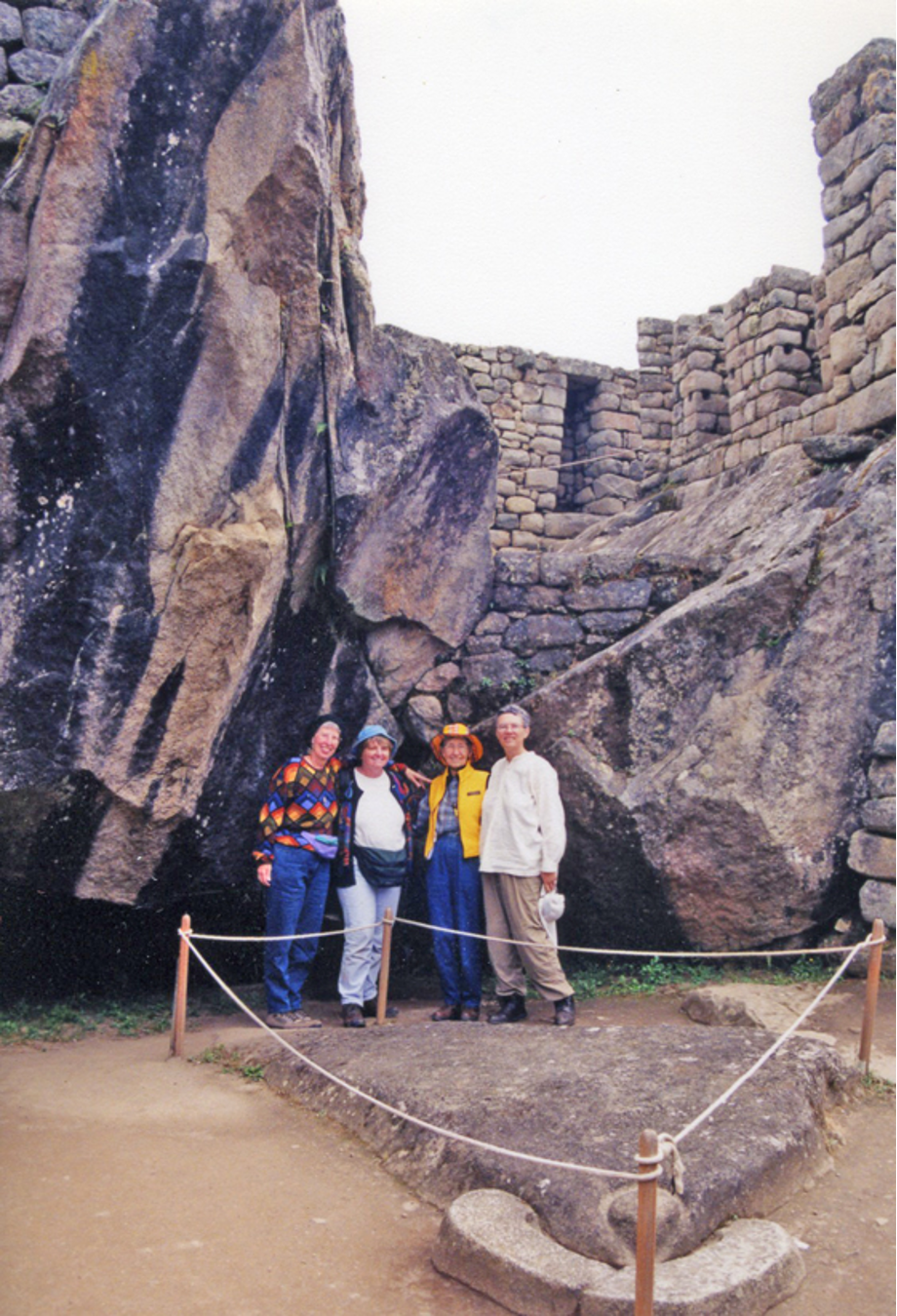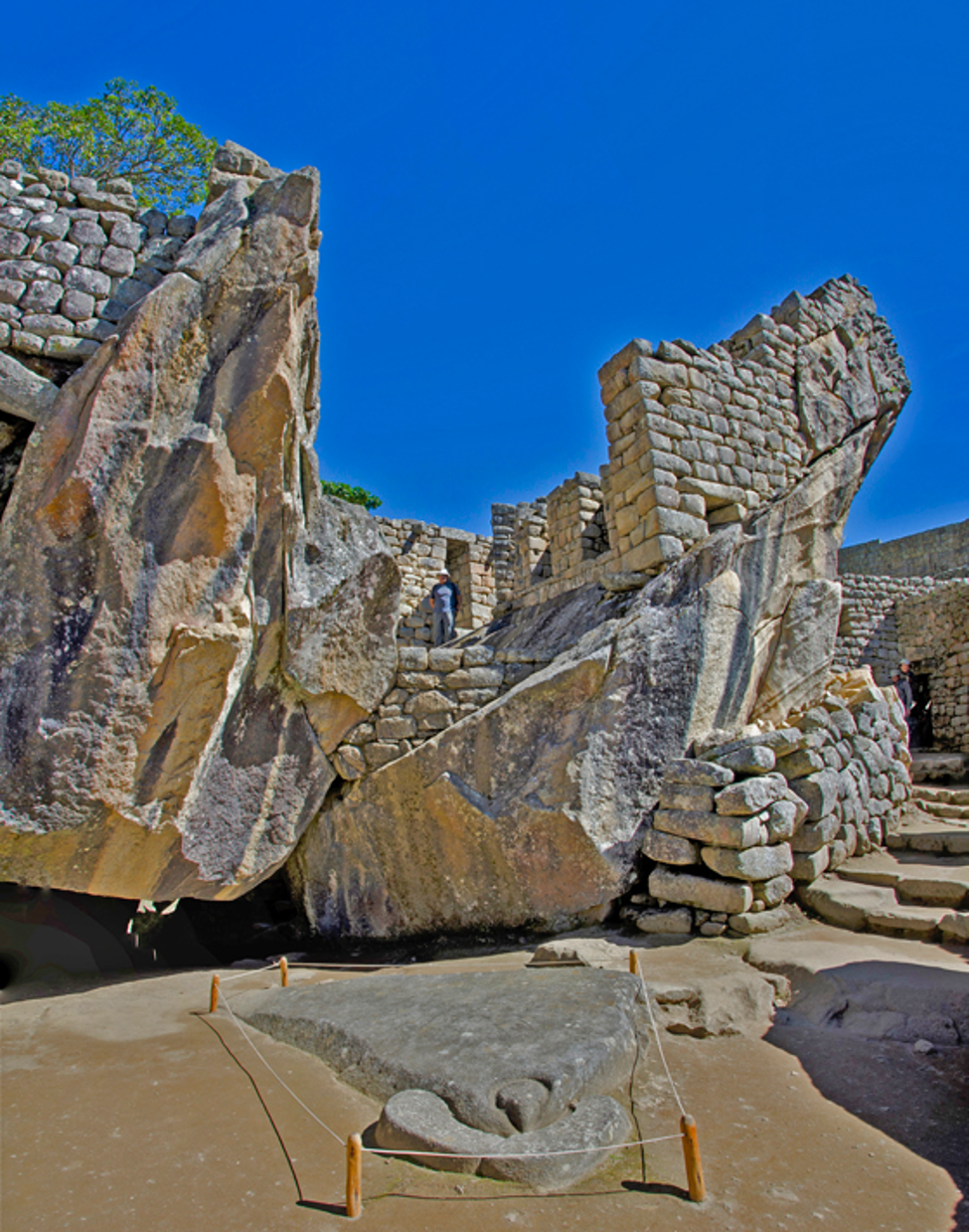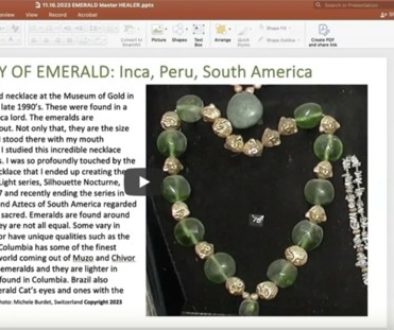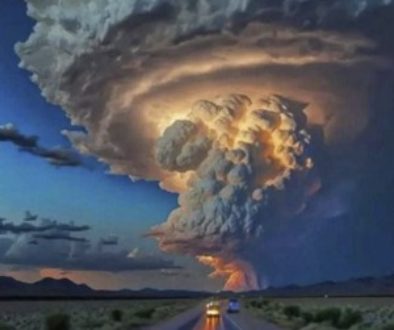The Three Lunar Temples At The Machu Picchu Complex: What Archeologists Missed
On 9.3.2021, I saw this in my newsfeed and I would advise you to read it first because my blog is an “answer” to what these archeologists do not know, and refuse to ask Quechua people who do know.
COMMENT: I’ve been to this particular Moon Temple a number of times. I refer to it as the River Lunar Temple.
The River Lunar Temple is located just outside the “gate” that leads from Machu Picchu (old mountain) and puts you on a trail that takes you to Huynu Picchu (the young mountain). In reality, there are three lunar/moon temples in the Machu Complex (which is comprised of Machu Picchu (old mountain), Huynu Picchu (young mountain) and Mama Putukusi. Combined, the three loaf-like lava mountains form a triangle deep in the Peruvian jungle near Cusco. The first Lunar Temple is situated at Machu Picchu.
The second Lunar Temple is off to the left of the trail just outside the gate leaving Machu Picchu. There’s a lot of jungle and debris along the way. Its slow going because it’s very steep and vegetation will trip you often. As you draw near you can hear the roar of the Urubamba River down below, a wild level 5 glacier from the Andes Mountains that surround the area and feed this mighty and powerful waterway.
When you stand just outside the River Lunar Temple, what few notice is the black lava “v-like” part of the cave which symbolizes a woman’s thighs spread in childbirth. It fits with theme of this River Lunar Temple.
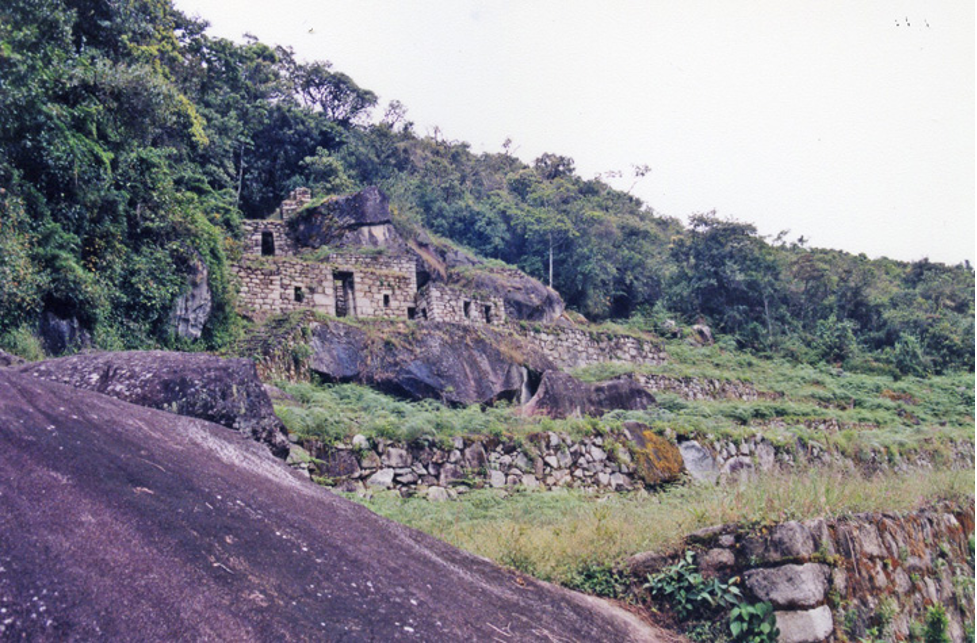
River Lunar Temple. As you descend to the river, you will see these stone houses above the actual cave containing the temple. The black lava rock you see on the left is one of the “V-like” legs that sit above the temples built into the cave itself.
Photo: Eileen Nauman
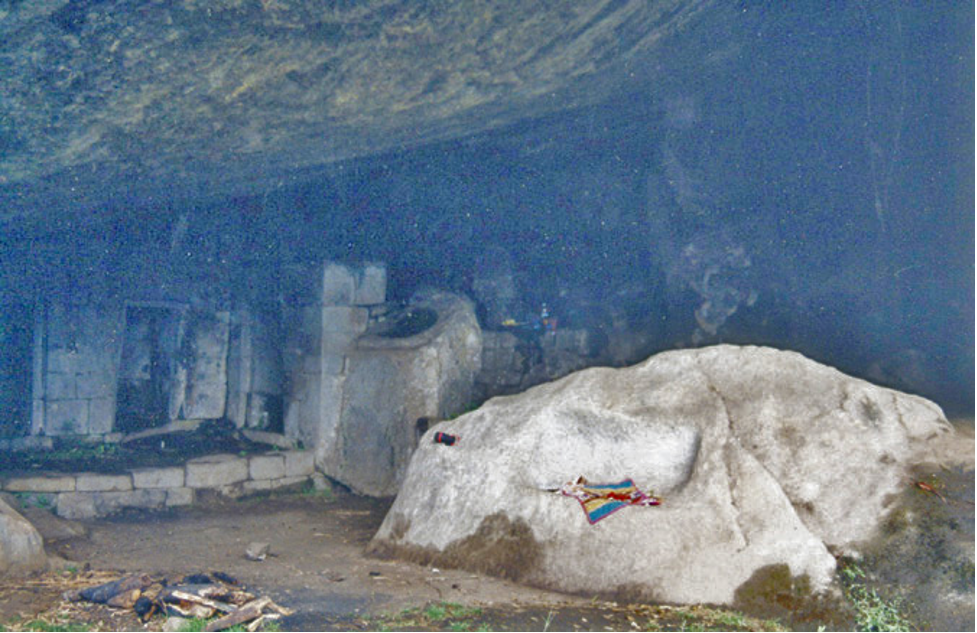
Here I’m in the cave where the temple is located. On the right, on a huge white boulder, I spread out my mesa which contained sacred items and cornmeal as an offering to the guardian spirits who watch over this place. Before entering, I stood at the entrance to the cave, gave my name, my reason for being there and asked for permission to come into the cave. I was granted permission. The interesting thing about the temple inside is that all of the windows are blocked up and you can’t see into the well-cut stones for the buildings. Not only that, but the door is a false door. There is no way you can get into the temple. What was the purpose? I would find out why later and will share the answer in another blog on false windows and doors found in the Machu Picchu Complex. PHOTO: Eileen Nauman
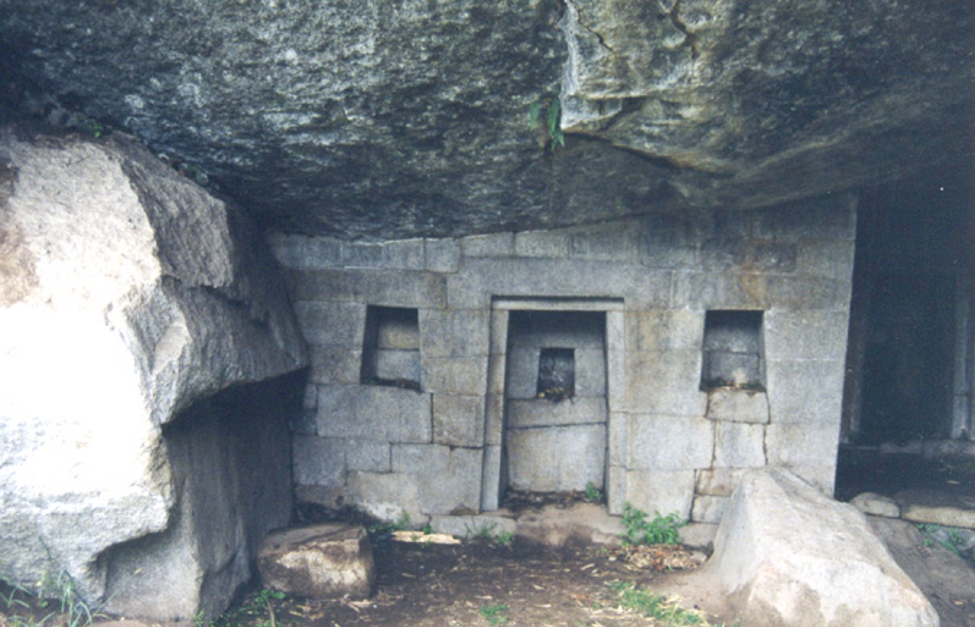
Here is the River Luna Temple that has been built within the cave. The two “windows” and “doorway” lead nowhere. They are false windows and doors. On each of the window niche shelves were offerings by others who had visited. I did not take photos or touch the objects placed here as they are sacred, and are prayers to the spirits of this cave.
The River Lunar Temple is next door in another cave, called the Nusta Cave. Inside are nine stone chairs that were fashioned by hand for the nine Nusta goddesses of the Quechua belief system. That the Moon Temple (representing women, fertility, life, and family) is right next door, is not an accident.
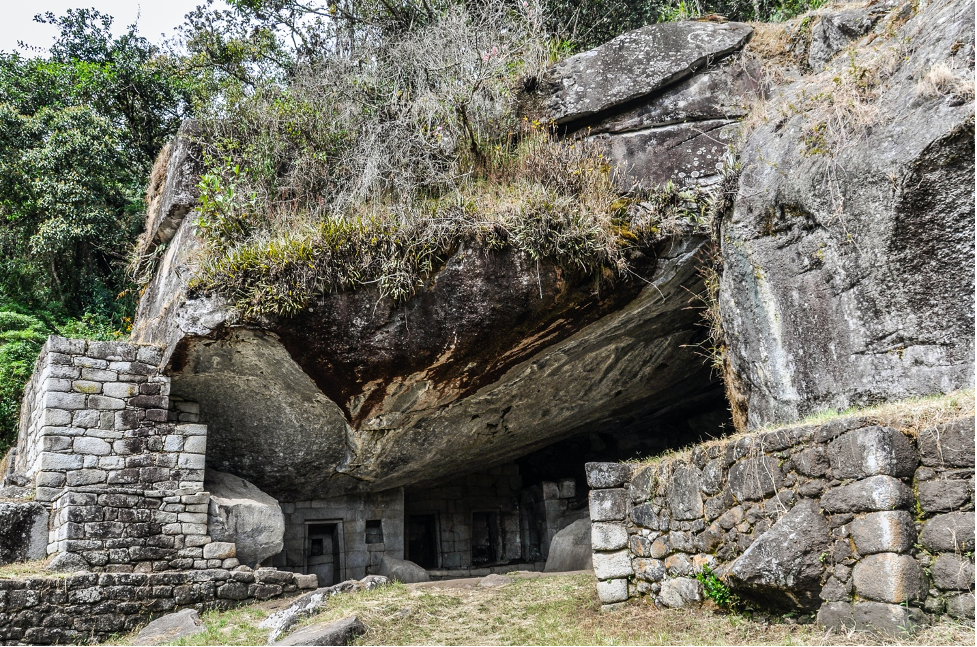
Here is the outside entrance to the River Luna Temple and Cave. Directly over the main inner temple are the spread black lava legs in a birthing position. Photo: Eileen Nauman
Not one archeologist put this together: Women/birth/goddesses/Moon Temple. Water only about two-hundred feet away. If you can get a bright sunny day, on the upper ceiling of the River Lunar Temple, it is a yellow ocher color with red which resembles blood from childbirth. Water symbolizes the amniotic fluid that surrounds a fetus as it grows in a woman’s body. The snake-like quality of the Urubamba which moves like one around the TRIANGLE of two male apus (mountain spirits) and one female apu (Mama Putukusi) is a part of this powerful energy hub that anchors this region of South America. Snakes are sacred and respected, and represent powerful energy and symbolize the Earth element.
In real time it is the priestesses/medicine women who know of the nine chairs in the Nusta cave and who come down to work with them. Each goddess rules over some part of our lives. Offerings and prayers are made by the supplicant to one of the Nustas who they are asking for healing or help from. People who are still connected to the Quechua beliefs come there to ask for help, for support, or to thank a particular Nusta for her magic, her intersession, or to grant a request that was prayed for by that human being. Typically, it is WOMEN who come to this temple to ask for help through prayer and gifts. It is, after all, a place for and about women. The “Air element” temple is up on Huynu Picchu. Both men and women go to it, but for different reasons. There is a ‘birthing passage’ that is high on this mountain that one must get down on their hands, knees, and sometimes their belly, and must crawl through it to be REBORN. Quechua teachers put their students through this process, but those of either gender can do it also as a symbolic rebirth—which leads us to WHY there is a Lunar Temple on this mountain in the first place. I guess the archeologists missed that one, too.
Apu (Quechua for ‘mountain spirit’) Yanantin is one of many apus who are part of the Ceque System of lines of energy through Cusco and the surrounding region (including the Machu Picchu complex and Vilcabamba). There is a great black basalt carved stone created to honor Pachamama (Mother Earth) just inside the gate where it is situated at one end of a plaza. The plaza contains two large thatched huts; one on each side of it. The Pachamama Stone is a profile of Apu Yanantin. It is a direct energy alignment between the apu, the stone, and the complex at Machu Picchu.
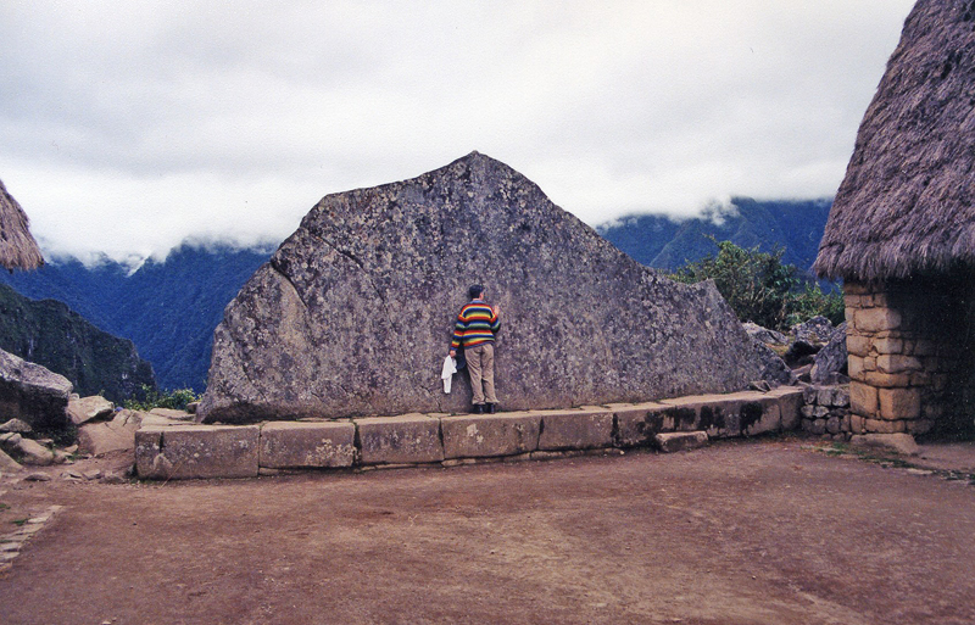
Here I am connecting telepathically with the Pachamama stone and you can see part of one of the two huts with their thatched rooves on the hard packed clay plaza between them. What you can’t see because of low-hanging clouds and fog keeping the mountain peaks hidden, is the Andean peak of Apu Yanantin—which is directly behind this beautiful hand carved monolith. Photo: Ruth Gent
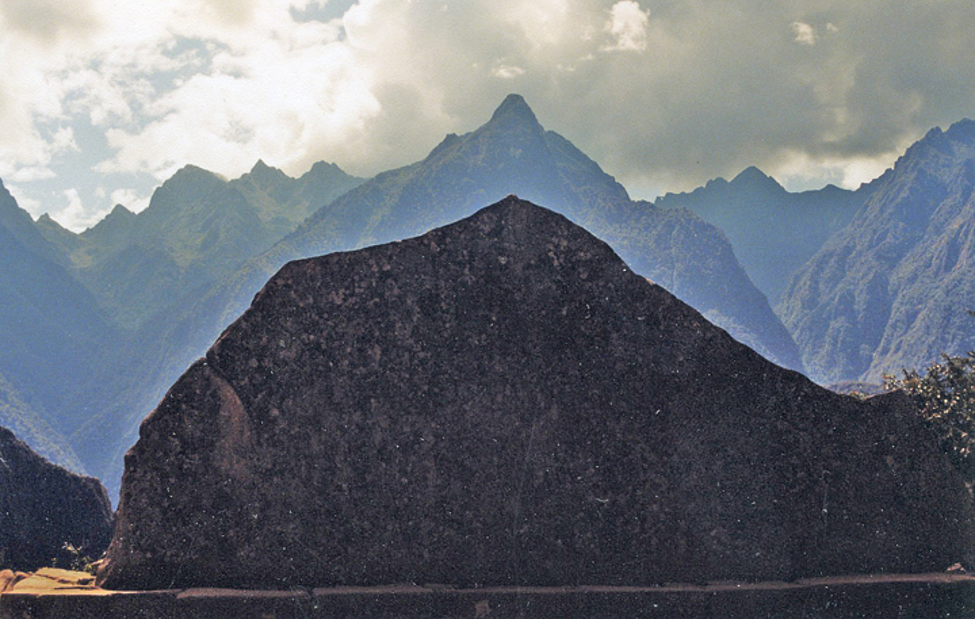
On another day, the fog lifted and in front is the Pachamama Stone and directly behind it you can see Apu Yanantin. Notice how the stone mimics the Apu’s profile. It is sending energy directly to the Pachamama Stone, and in turn, she sends it to supplicants who stand in her plaza between the two stone thatched-roof huts that are on either side of it.
There is another very important and little-known function of this plaza. If you stand between the two huts, face the Pachamama Stone and Apu Yanantin, soften your knees, close your eyes and stand relaxed, the magic begins. You will begin to sway slowly and gently in all four directions. To the left, the right, forward and back, standing grounded and feet unmoving. This is the energy of the apu being focused through the Pachamama stone directly onto the supplicants. What it is doing is aligning and harmonizing each person’s aura to be “cleansed” and “cleared” of positive ions which clog our chakra openings as well are “dust bunnies” in the 9 fields of our aura which surround us so that the supplicant can visit the River Moon Temple or the Lunar Temple atop Huynu Picchu, or go to the Lunar Temple on Machu Picchu. To be “cleansed” and made “sacred” in the Pachamama Plaza is a sign of respect toward the sacredness of these temples and the spirit guardians who are present in each one.
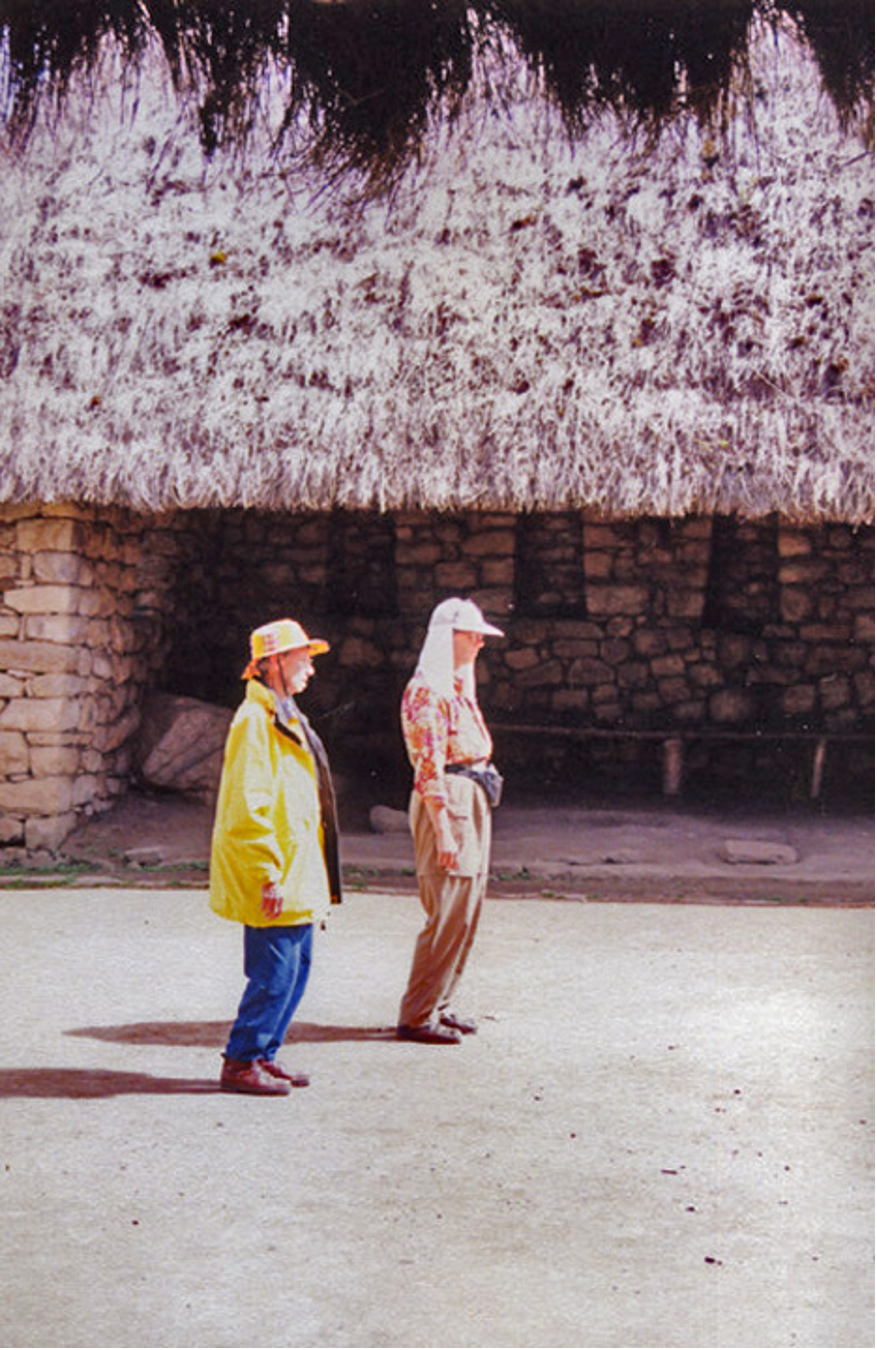
Here, my mother Ruth Gent and I are standing in the center, facing the Pachamama Stone and Lord (Apu) Yanantin. You can see that our feet are flat on the ground, our knees “soft” and slightly bent, eyes closed, and we’re standing relaxed. One can literally feel the energy coming through you—a mild pulsing sensation. It takes about a minute or two before the pulsing stops, which means someone is now “clean” and declared “sacred” for this work in the Machu Picchu complex. We did this first thing every morning we came to the complex from Aguas Caliente, a short distance down at the foot of Machu Picchu.
A woman going down to the Nusta’s Cave/River Moon Temple next to the Urubamba River, or a man or woman climbing up the trail to go visit the Temple of the Moon which was built at the top of Huynu Picchu, have to be “clean” to visit these powerful, healing sacred sites. It’s akin to taking a bath and putting on your Sunday best before you attend church services. The plaza I speak about was utilized by priestesses, priests and common people who came to Machu Picchu to go to one of these three powerful healing temples. Of course, the archeologists missed the fact there’s three lunar temples at all. How easy it would have been to seek out a medicine woman or man instead and ask them about it. Right?
Apu Yanantin works in concert with a number of apus that surround the complex. Their energy stretches far beyond what the eye can see if you stand atop Huynu Picchu—which is much higher altitude-wise than Machu Picchu itself. In fact, if you visit the Lunar Temple on Huynu Picchu on the eastern side, there is a huge, black basalt lava triangular one-piece stone that was carved and stands along the trail nearby. This triangle behaves like a “radar dome” in that certain apus (unseen by us standing there) from across the Atlantic Ocean, are connected to mighty apus in Europe and Asia. There is an unbroken “ring” or “circle” around Mother Earth, all connected by energy alignments via the mountains in these ranges or stand-alone mountains that keep this energy at a certain frequency and power. Why? Because it is the mountain ranges of the world that keep this planet stable. Without this energy connection, we would be in chaos and not too many people would be alive as a result of its loss.
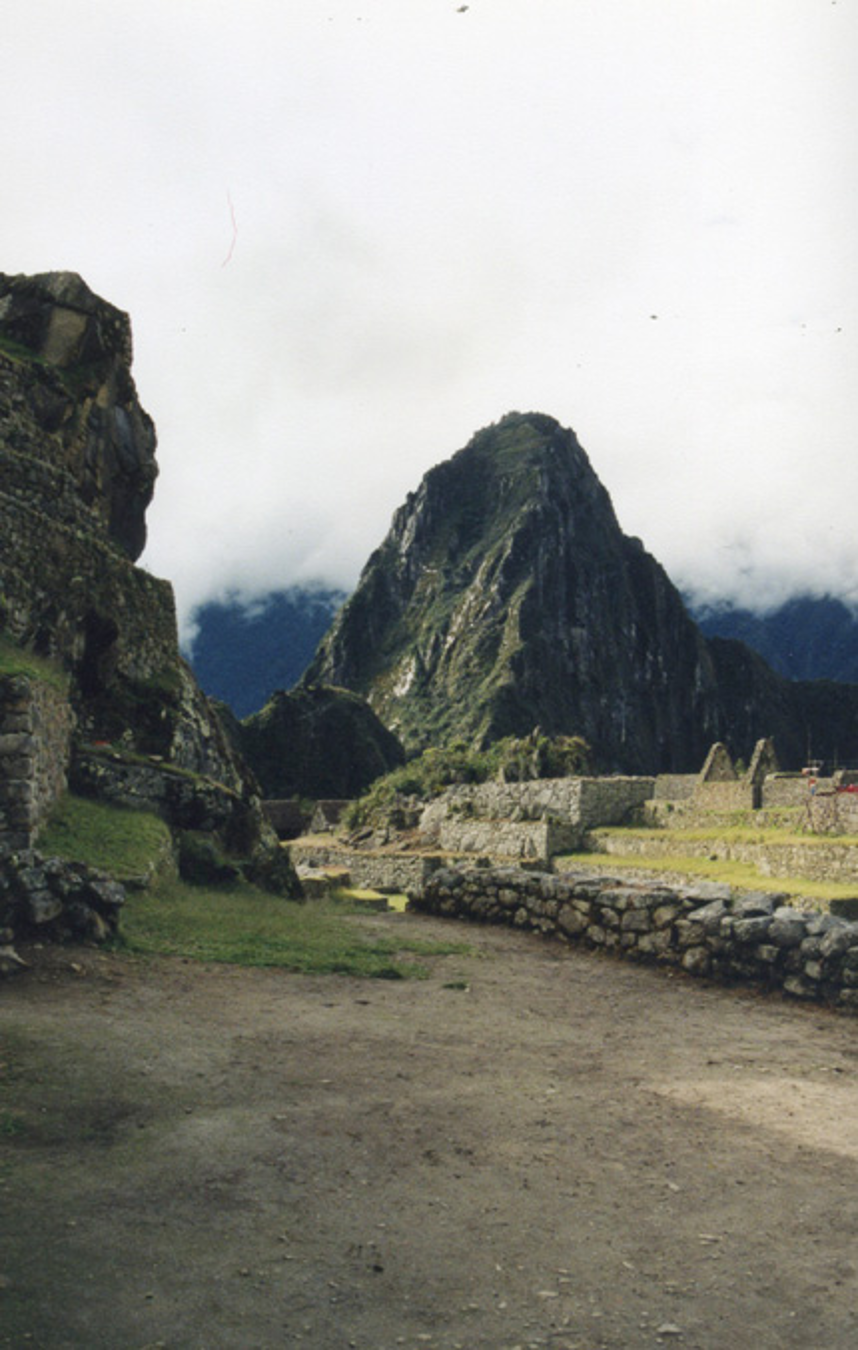
Huynu Picchu, the young mountain. At the top of it (a very long, arduous climb but worth it), is a birthing place through which a person can crawl, mimicking birth from the mother’s womb and be reborn. A Lunar Temple with a thousand short, steeply vertical steps, and a triangular piece of lava that acts as a radar sending the receiving apu energy signals and moving them either to apus in a large region, or moving them across the Atlantic Ocean to mountains or ranges in Europe and Asia.
If you stand in the center of the flat, stone triangle that is roughly fifteen feet high at its point, fifteen feet wide at the base, and the two sides of it the same measurement, you will feel a powerful “rhythmic pulsing” of energy coming into this “radar” which is then sent back out in different directions, “feeding” regional apus in this area of Peru. All of this stabilizes the earth, reduces earthquakes and crust movement, and keeps the planet moving at a certain speed, through space, giving it stability.
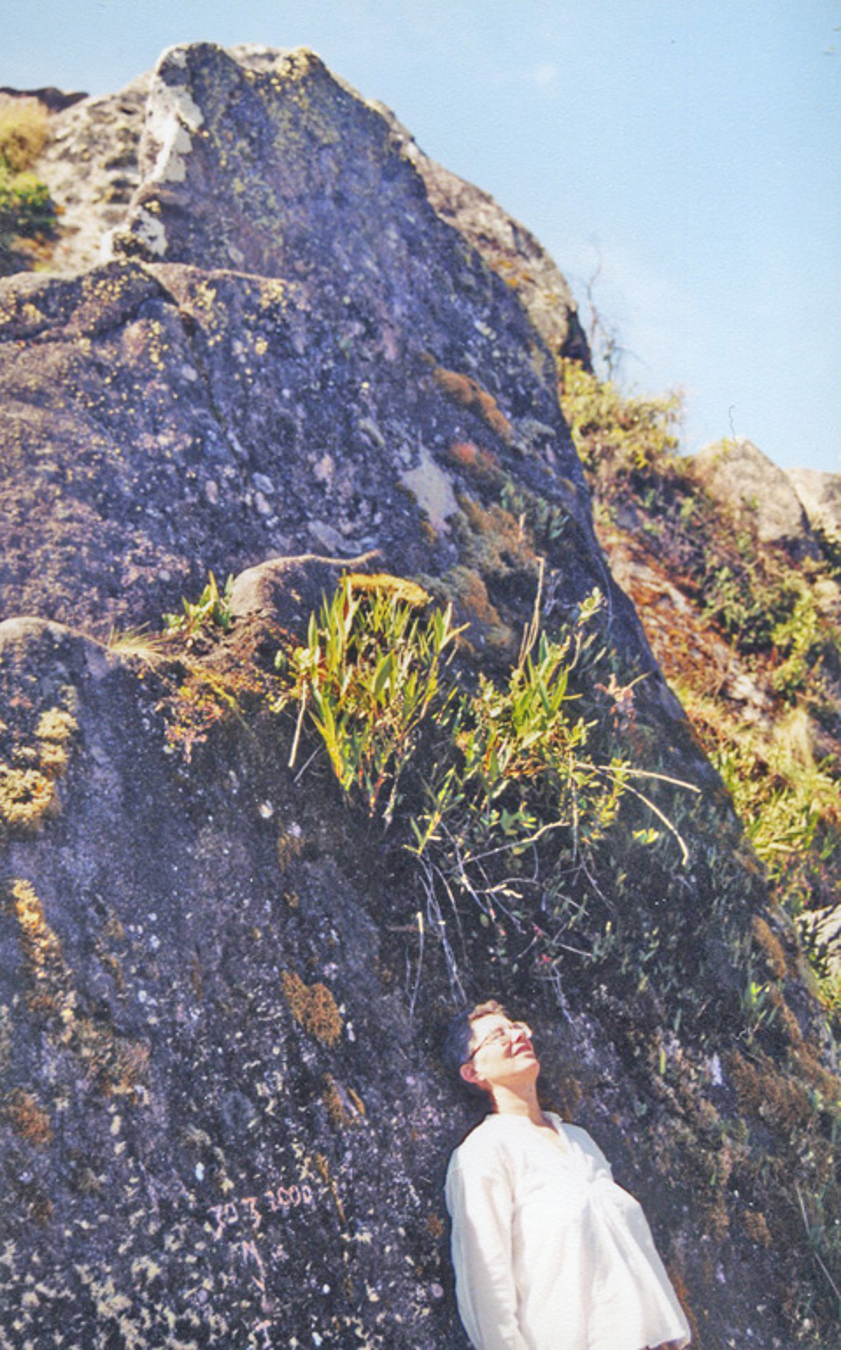
Here, I am in the middle of the black basalt triangle at the top of Huynu Picchu, receiving a rhythmic pulsing that is absolutely palpable. It was an amazing experience!
Here is the “radar dome” as I refer to this black basalt lava triangular monolith that sits on the east side of Huynu Picchu, right at the top of the mountain. It is roughly fifteen feet wide at the base, the right and left sides are the same measurement, making it nearly an equilateral triangle. Its function is to send and receive, and pass on energy from other apus either from the region or from across the Atlantic Ocean, having connection with European and Asian mountain ranges and particular mountain peaks. It is part of the closed network of energy that the mountains around this planet are connected with to keep it physically sustainable and stable.
PHOTO: Eileen Nauman
Why doesn’t anyone who is an archeologist ever ask: Why are there three lunar/moon temples in such a small, concentrated area? One is on Machu Picchu and works with the EARTH ELEMENT. The Condor Temple is there, as well. The “wings” of the condor are symbolic of the air and of the living connection to the Emperor and Empress who have recently emerged to begin to create the 5th world: the world of the heart and of love, who rule creation, according to the Quechua people.
My mother Ruth Gent in her yellow vest and I’m on her left. There are two other ladies and we all wanted a photo of the magnificently shaped condor with the white ruff around its neck and hewn out of black basalt lava for its body and head. The “wings” are behind us. PHOTO: David Nauman
There is the River Lunar Temple which works with the spirits of the water. The one on top of Huynu Picchu works with the element of air. They are representative of different major spiritual elements that create the volume of energy which is manifested at this complex. Furthermore, the element fire is also here in this alchemical mix. The entire region is volcanic and these three mountains of the Machu Picchu complex are pure black basalt/lava and were created by fissures opening up in the Earth’s crust and lava oozing out and creating them.
This is the Condor Temple at Mach Picchu. You can see the broadly shaped “wings” behind it. This is a temple in which I had a powerful shamanic journey inside at a later date. PHOTO: Eileen Nauman
The air element also represented at Machu Picchu is the Condor Temple where a condor has been carved out of stone and laid out in the middle of the temple. Condors are considered lords of the air element. If you look up, you will see the “wings” of it. Air is one of the major elements represented here at the complex: Earth, Water, Fire and Air. The alchemical recipe for a major energy center that is alive, productive, online, and fully functioning to this day.
Now, dear readers, you know far more than any of these archeologists who think they know so much. In reality, they know so little. Their arrogance is in not contacting local Quechua elders who know what I know—and know much more than I do, and could have told them what I’ve just told you.
